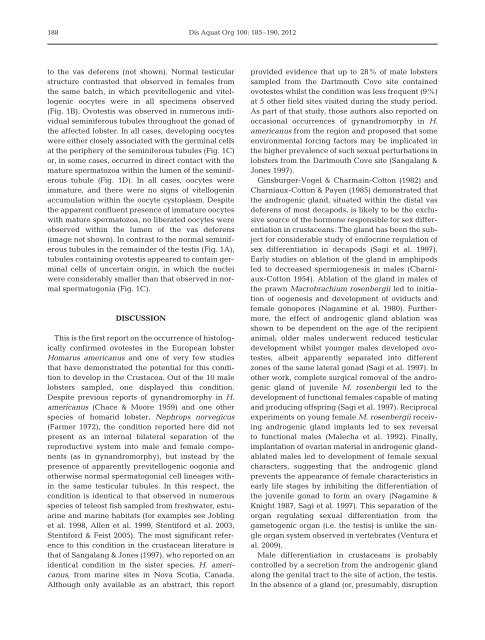Histological intersex (ovotestis) in the European lobster Homarus ...
Histological intersex (ovotestis) in the European lobster Homarus ...
Histological intersex (ovotestis) in the European lobster Homarus ...
Create successful ePaper yourself
Turn your PDF publications into a flip-book with our unique Google optimized e-Paper software.
188<br />
Dis Aquat Org 100: 185–190, 2012<br />
to <strong>the</strong> vas deferens (not shown). Normal testicular<br />
structure contrasted that observed <strong>in</strong> females from<br />
<strong>the</strong> same batch, <strong>in</strong> which previtellogenic and vitellogenic<br />
oocytes were <strong>in</strong> all specimens observed<br />
(Fig. 1B). Ovotestis was observed <strong>in</strong> numerous <strong>in</strong>dividual<br />
sem<strong>in</strong>iferous tubules throughout <strong>the</strong> gonad of<br />
<strong>the</strong> affected <strong>lobster</strong>. In all cases, develop<strong>in</strong>g oocytes<br />
were ei<strong>the</strong>r closely associated with <strong>the</strong> germ<strong>in</strong>al cells<br />
at <strong>the</strong> periphery of <strong>the</strong> sem<strong>in</strong>iferous tubules (Fig. 1C)<br />
or, <strong>in</strong> some cases, occurred <strong>in</strong> direct contact with <strong>the</strong><br />
mature spermatozoa with<strong>in</strong> <strong>the</strong> lumen of <strong>the</strong> sem<strong>in</strong>iferous<br />
tubule (Fig. 1D). In all cases, oocytes were<br />
immature, and <strong>the</strong>re were no signs of vitellogen<strong>in</strong><br />
accumulation with<strong>in</strong> <strong>the</strong> oocyte cystoplasm. Despite<br />
<strong>the</strong> apparent confluent presence of immature oocytes<br />
with mature spermatozoa, no liberated oocytes were<br />
observed with<strong>in</strong> <strong>the</strong> lumen of <strong>the</strong> vas deferens<br />
(image not shown). In contrast to <strong>the</strong> normal sem<strong>in</strong>iferous<br />
tubules <strong>in</strong> <strong>the</strong> rema<strong>in</strong>der of <strong>the</strong> testis (Fig. 1A),<br />
tubules conta<strong>in</strong><strong>in</strong>g <strong>ovotestis</strong> appeared to conta<strong>in</strong> germ<strong>in</strong>al<br />
cells of uncerta<strong>in</strong> orig<strong>in</strong>, <strong>in</strong> which <strong>the</strong> nuclei<br />
were considerably smaller than that observed <strong>in</strong> normal<br />
spermatogonia (Fig. 1C).<br />
DISCUSSION<br />
This is <strong>the</strong> first report on <strong>the</strong> occurrence of histologically<br />
confirmed ovotestes <strong>in</strong> <strong>the</strong> <strong>European</strong> <strong>lobster</strong><br />
<strong>Homarus</strong> americanus and one of very few studies<br />
that have demonstrated <strong>the</strong> potential for this condition<br />
to develop <strong>in</strong> <strong>the</strong> Crustacea. Out of <strong>the</strong> 10 male<br />
<strong>lobster</strong>s sampled, one displayed this condition.<br />
Despite previous reports of gynandromorphy <strong>in</strong> H.<br />
americanus (Chace & Moore 1959) and one o<strong>the</strong>r<br />
species of homarid <strong>lobster</strong>, Nephrops norvegicus<br />
(Farmer 1972), <strong>the</strong> condition reported here did not<br />
present as an <strong>in</strong>ternal bilateral separation of <strong>the</strong><br />
reproductive system <strong>in</strong>to male and female components<br />
(as <strong>in</strong> gynandromorphy), but <strong>in</strong>stead by <strong>the</strong><br />
presence of apparently previtellogenic oogonia and<br />
o<strong>the</strong>rwise normal spermatogonial cell l<strong>in</strong>eages with -<br />
<strong>in</strong> <strong>the</strong> same testicular tubules. In this respect, <strong>the</strong><br />
condition is identical to that observed <strong>in</strong> numerous<br />
species of teleost fish sampled from freshwater, estuar<strong>in</strong>e<br />
and mar<strong>in</strong>e habitats (for examples see Jobl<strong>in</strong>g<br />
et al. 1998, Allen et al. 1999, Stentiford et al. 2003,<br />
Stentiford & Feist 2005). The most significant reference<br />
to this condition <strong>in</strong> <strong>the</strong> crustacean literature is<br />
that of Sangalang & Jones (1997), who reported on an<br />
identical condition <strong>in</strong> <strong>the</strong> sister species, H. americanus,<br />
from mar<strong>in</strong>e sites <strong>in</strong> Nova Scotia, Canada.<br />
Although only available as an abstract, this report<br />
provided evidence that up to 28% of male <strong>lobster</strong>s<br />
sampled from <strong>the</strong> Dartmouth Cove site conta<strong>in</strong>ed<br />
ovotestes whilst <strong>the</strong> condition was less frequent (9%)<br />
at 5 o<strong>the</strong>r field sites visited dur<strong>in</strong>g <strong>the</strong> study period.<br />
As part of that study, those authors also reported on<br />
occasional occurrences of gynandromorphy <strong>in</strong> H.<br />
americanus from <strong>the</strong> region and proposed that some<br />
environmental forc<strong>in</strong>g factors may be implicated <strong>in</strong><br />
<strong>the</strong> higher prevalence of such sexual perturbations <strong>in</strong><br />
<strong>lobster</strong>s from <strong>the</strong> Dartmouth Cove site (Sangalang &<br />
Jones 1997).<br />
G<strong>in</strong>sburger-Vogel & Charma<strong>in</strong>-Cotton (1982) and<br />
Charniaux-Cotton & Payen (1985) demonstrated that<br />
<strong>the</strong> androgenic gland, situated with<strong>in</strong> <strong>the</strong> distal vas<br />
deferens of most decapods, is likely to be <strong>the</strong> exclusive<br />
source of <strong>the</strong> hormone responsible for sex differentiation<br />
<strong>in</strong> crustaceans. The gland has been <strong>the</strong> subject<br />
for considerable study of endocr<strong>in</strong>e regulation of<br />
sex differentiation <strong>in</strong> decapods (Sagi et al. 1997).<br />
Early studies on ablation of <strong>the</strong> gland <strong>in</strong> amphipods<br />
led to decreased spermiogenesis <strong>in</strong> males (Charniaux-Cotton<br />
1954). Ablation of <strong>the</strong> gland <strong>in</strong> males of<br />
<strong>the</strong> prawn Macrobrachium rosenbergii led to <strong>in</strong>itiation<br />
of oogenesis and development of oviducts and<br />
female gonopores (Nagam<strong>in</strong>e et al. 1980). Fur<strong>the</strong>rmore,<br />
<strong>the</strong> effect of androgenic gland ablation was<br />
shown to be dependent on <strong>the</strong> age of <strong>the</strong> recipient<br />
animal; older males underwent reduced testicular<br />
development whilst younger males developed ovo -<br />
testes, albeit apparently separated <strong>in</strong>to different<br />
zones of <strong>the</strong> same lateral gonad (Sagi et al. 1997). In<br />
o<strong>the</strong>r work, complete surgical removal of <strong>the</strong> androgenic<br />
gland of juvenile M. rosenbergii led to <strong>the</strong><br />
development of functional females capable of mat<strong>in</strong>g<br />
and produc<strong>in</strong>g offspr<strong>in</strong>g (Sagi et al. 1997). Reciprocal<br />
experiments on young female M. rosenbergii receiv<strong>in</strong>g<br />
androgenic gland implants led to sex reversal<br />
to functional males (Malecha et al. 1992). F<strong>in</strong>ally,<br />
implantation of ovarian material <strong>in</strong> androgenic glandablated<br />
males led to development of female sexual<br />
characters, suggest<strong>in</strong>g that <strong>the</strong> androgenic gland<br />
prevents <strong>the</strong> appearance of female characteristics <strong>in</strong><br />
early life stages by <strong>in</strong>hibit<strong>in</strong>g <strong>the</strong> differentiation of<br />
<strong>the</strong> juvenile gonad to form an ovary (Nagam<strong>in</strong>e &<br />
Knight 1987, Sagi et al. 1997). This separation of <strong>the</strong><br />
organ regulat<strong>in</strong>g sexual differentiation from <strong>the</strong><br />
gametogenic organ (i.e. <strong>the</strong> testis) is unlike <strong>the</strong> s<strong>in</strong>gle<br />
organ system observed <strong>in</strong> vertebrates (Ventura et<br />
al. 2009).<br />
Male differentiation <strong>in</strong> crustaceans is probably<br />
controlled by a secretion from <strong>the</strong> androgenic gland<br />
along <strong>the</strong> genital tract to <strong>the</strong> site of action, <strong>the</strong> testis.<br />
In <strong>the</strong> absence of a gland (or, presumably, disruption
















